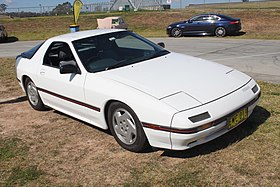Mazda RX-7
| Mazda RX-7 | |
|---|---|

Mazda RX-7 FD3S
|
|
| Overview | |
| Manufacturer | Mazda |
| Production | 1978–2002 811,634 produced |
| Assembly | Hiroshima Assembly, Hiroshima, Japan |
| Body and chassis | |
| Class | Sports car |
| Body style | 2 door coupe 2 door convertible |
| Layout | FMR layout |
| Chronology | |
| Predecessor | Mazda RX-3 |
| Successor | Mazda RX-8 |
| SA/FB | |
|---|---|
 |
|
| Overview | |
| Also called | Mazda Savanna RX-7 |
| Production | 1978–1985 471,018 produced |
| Designer | Matasaburo Maeda (1976) |
| Body and chassis | |
| Body style | 2 door coupe |
| Powertrain | |
| Engine |
|
| Transmission | |
| Dimensions | |
| Wheelbase | 2,420 mm (95 in) |
| Length | 4,285 mm (169 in) |
| Width | 1,675 mm (66 in) |
| Height | 1,260 mm (50 in) |
| Curb weight | 1,000–1,100 kg (2,300–2,500 lb) |
| FC | |
|---|---|
 |
|
| Overview | |
| Also called | Mazda Savanna RX-7 |
| Production | S4 (1985 - 1988) – S5(1989 - 1991) 272,027 produced |
| Body and chassis | |
| Body style | 2 door coupe 2 door convertible |
| Powertrain | |
| Engine |
1.3L 150 PS (110 kW) S4 Naturally aspirated 13B 1.3L 185 PS (136 kW) S4 Turbocharged 13B 1.3L 160 hp (119 kW) S5 Naturally aspirated 13B 1.3L 202–215 hp (151–160 kW) S5 Turbocharged 13B |
| Dimensions | |
| Wheelbase | 2,431 mm (95.7 in) |
| Length | 1986-88: 4,290 mm (168.9 in) 1989–1991: 4,315 mm (169.9 in) |
| Width | 1,689 mm (66.5 in) |
| Height | 1,265 mm (49.8 in) |
| Curb weight | 1,223–1,584 kg (2,696–3,492 lb) |
| FD | |
|---|---|
 |
|
| Overview | |
| Also called | ɛ̃fini RX-7 |
| Production | 1991–2002 68,589 produced |
| Designer | Yoichi Sato (1988) |
| Body and chassis | |
| Body style | 2 door coupe |
| Powertrain | |
| Engine |
1.3L Twin turbo 255 PS (188 kW; 252 hp) 13B-REW |
| Transmission | 4-speed automatic 5-speed manual |
| Dimensions | |
| Wheelbase | 2,425 mm (95 in) |
| Length | 4,285 mm (169 in) |
| Width | 1,760 mm (69 in) |
| Height | 1,230 mm (48 in) |
| Curb weight | 1,218–1,340 kg (2,685–2,954 lb) |
The Mazda RX-7 is a sports car that was produced by the Japanese automaker Mazda from 1978 to 2002. The first RX-7 featured an 1,146 cc (69.9 cu in) twin-rotor Wankel rotary engine and a front-midship, rear-wheel drive layout. The RX-7 replaced the RX-3, with both models sold in Japan as the Mazda Savanna.
The original RX-7 was a sports car with pop-up headlamps. The compact and lightweight Wankel rotary engine is situated slightly behind the front axle, a configuration marketed by Mazda as "front mid-engine". It was offered as a two-seat coupé, with optional "occasional" rear seats in Japan, Australia, the United States, and other parts of the world. The rear seats were initially marketed as a dealer-installed option for the North American markets.
The RX-7 made Car and Driver magazine's Ten Best list five times. 811,634 RX-7s were produced.
The RX-7 has become notable through pop culture such as Battle Fever J, Ultraman 80, Space Sheriff Shaider, Kyojuu Tokusou Juspion, Choudenshi Bioman, Shakotan Boogie, Kamen Rider Black RX, Wangan Midnight, Super Rescue Solbrain, Initial D, Need for Speed, The Fast and the Furious series, Forza Motorsport and Gran Turismo.
...
Wikipedia
